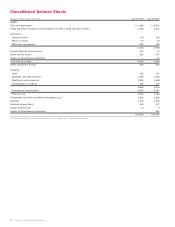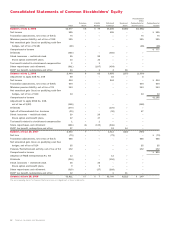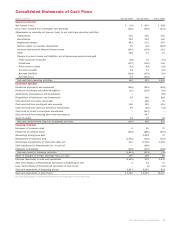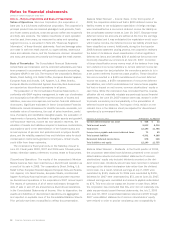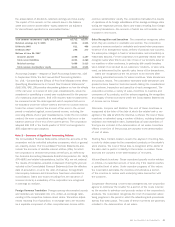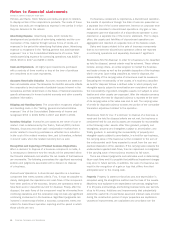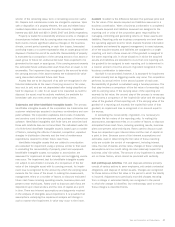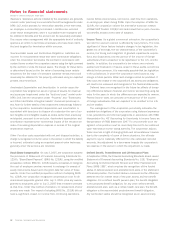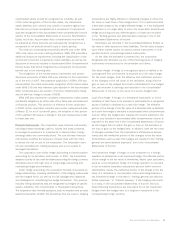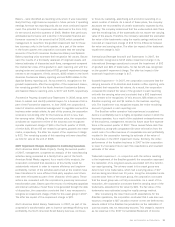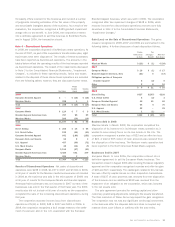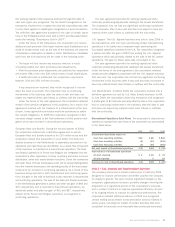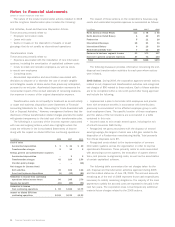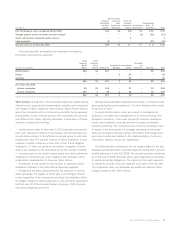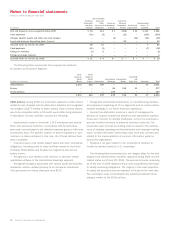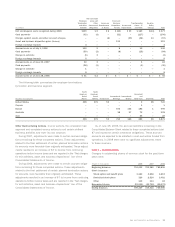Sara Lee 2008 Annual Report Download - page 51
Download and view the complete annual report
Please find page 51 of the 2008 Sara Lee annual report below. You can navigate through the pages in the report by either clicking on the pages listed below, or by using the keyword search tool below to find specific information within the annual report.underfunded status should be recognized as a liability. As part
of the initial recognition of the funded status, any transitional
asset/(liability), prior service cost (credit) or actuarial (gain)/loss
that had not yet been recognized as a component of net periodic
cost was recognized in the accumulated other comprehensive income
section of the Consolidated Statements of Common Stockholders’
Equity, net of tax. Accumulated other comprehensive income will
be adjusted as these amounts are subsequently recognized as a
component of net periodic benefit costs in future periods.
The method of calculating net periodic benefit cost under SFAS
158 is the same as under existing practices. SFAS 158 prescribes
additional disclosure requirements including the classification of the
current and noncurrent components of plan liabilities, as well as the
disclosure of amounts included in Accumulated Other Comprehensive
Income (Loss) that will be recognized as a component of net periodic
benefit cost in the following year.
The recognition of the funded status requirement and certain
disclosure provisions of SFAS 158 were effective for the corporation
as of the end of 2007. Retrospective application of SFAS 158 was
not permitted. The initial incremental recognition of the funded status
under SFAS 158 that was reflected upon adoption in the Accumulated
Other Comprehensive Loss section of Common Stockholders’ Equity
was an after tax charge to equity of $168.
SFAS 158 also requires the consistent measurement of plan assets
and benefit obligations as of the date of the fiscal year end statement
of financial position. This provision is effective for the corporation
in 2009. As the corporation currently uses a plan measurement date
of March 31 for all of its benefit plans, the adoption of this portion
of the standard will require a change in the plan measurement date
to fiscal year end.
Financial Instruments The corporation uses financial instruments,
including forward exchange, options, futures and swap contracts,
to manage its exposures to movements in interest rates, foreign
exchange rates and commodity prices. The use of these financial
instruments modifies the exposure of these risks with the intent
to reduce the risk or cost to the corporation. The corporation does
not use derivatives for trading purposes and is not a party to
leveraged derivatives.
The corporation uses either hedge accounting or mark-to-market
accounting for its derivative instruments. In 2007, the corporation
adopted a policy to use mark-to-market accounting for foreign currency
derivatives due to the high cost of using hedge accounting and
maintaining hedge documentation.
Under hedge accounting, the corporation formally documents its
hedge relationships, including identification of the hedging instruments
and the hedged items, as well as its risk management objectives
and strategies for undertaking the hedge transaction. This process
includes linking derivatives that are designated as hedges of specific
assets, liabilities, firm commitments or forecasted transactions.
The corporation also formally assesses, both at inception and at least
quarterly thereafter, whether the derivatives that are used in hedging
transactions are highly effective in offsetting changes in either the
fair value or cash flows of the hedged item. If it is determined that
a derivative ceases to be a highly effective hedge, or if the anticipated
transaction is no longer likely to occur, the corporation discontinues
hedge accounting and any deferred gains or losses are recorded
in the “Selling, general and administrative expenses” line in the
Consolidated Statements of Income.
Derivatives are recorded in the Consolidated Balance Sheets at
fair value in other assets and other liabilities. The fair value is based
upon either market quotes for actively traded instruments or inde-
pendent bids for non-exchange-traded instruments.
On the date the derivative is entered into, the corporation
designates the derivative as one of the following types of hedging
instruments and accounts for the derivative as follows:
Fair Value Hedge
A hedge of a recognized asset or liability or an
unrecognized firm commitment is declared as a fair value hedge.
For fair value hedges, both the effective and ineffective portions
of the changes in the fair value of the derivative, along with the
gain or loss on the hedged item that is attributable to the hedged
risk, are recorded in earnings and reported in the Consolidated
Statements of Income on the same line as the hedged item.
Cash Flow Hedge
A hedge of a forecasted transaction or of the
variability of cash flows to be received or paid related to a recognized
asset or liability is declared as a cash flow hedge. The effective
portion of the change in the fair value of a derivative that is declared
as a cash flow hedge is recorded in accumulated other comprehensive
income. When the hedged item impacts the income statement, the
gain or loss included in accumulated other comprehensive income is
reported on the same line in the Consolidated Statements of Income
as the hedged item to match the gain or loss on the derivative to
the loss or gain on the hedged item. In addition, both the fair value
of changes excluded from the corporation’s effectiveness assess-
ments and the ineffective portion of the changes in the fair value
of derivatives used as cash flow hedges are reported in the “Selling,
general and administrative expenses” line in the Consolidated
Statements of Income.
Net Investment Hedge
A hedge of a net investment in a foreign
operation is declared as a net investment hedge. The effective portion
of the change in the fair value of derivatives, based upon spot rates,
used as a net investment hedge of a foreign operation is recorded
in the cumulative translation adjustment account within common
stockholders’ equity. The ineffective portion of the change in the fair
value of a derivative or non-derivative instrument designated as a
net investment hedge is recorded in “Selling, general and adminis-
trative expenses,” or “Interest expense,” if the hedging instrument
is a swap, in the Consolidated Statements of Income. Non-U.S.
dollar financing transactions are accounted for as net investment
hedges when the hedged item is a long-term investment in the
corresponding foreign currency.
Sara Lee Corporation and Subsidiaries 49



